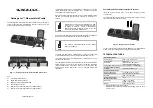
Problem Solution
If the sensor assembly is too close (less than 1.5m), move
the sensor assembly away from the display console.
Make sure the remote sensor LCD display is working
and the transmitter light is flashing once per 60 seconds.
Install a fresh set of batteries in the remote
thermo-hygrometer. For cold weather environments,
install lithium batteries.
Make sure the remote sensors are not transmitting
through solid metal (acts as an RF shield), or earth
barrier (down a hill).
Move the display console around electrical noise
generating devices, such as computers, TVs and other
wireless transmitters or receivers.
Move the remote sensor to a higher location. Move the
remote sensor to a closer location.
Temperature sensor reads too high in the
day time.
Make sure the thermo-hygrometer is mounted in a
shaded area. The pre preferred location is a north facing
wall because it is in the shade most of the day.
Indoor and Outdoor Temperature do not
agree
Allow up to one hour for the sensors to stabilize due to
signal filtering. The indoor and outdoor temperature
sensors should agree within 2 °C (the sensor accuracy is
± 1 °C).
Use the calibration feature to match the indoor and
outdoor temperature to a known source.
Indoor and Outdoor Humidity do not
agree
Allow up to one hour for the sensors to stabilize due to
signal filtering. The indoor and outdoor humidity sensors
should agree within 10 % (the sensor accuracy is ± 5 %).
Use the calibration feature to match the indoor and
outdoor humidity to a known source.
Display console contrast is weak
Replace console batteries with a fresh set of batteries.
Outdoor color does not change as
expected.
Make sure the outdoor sensor is assigned to Channel 1.


































